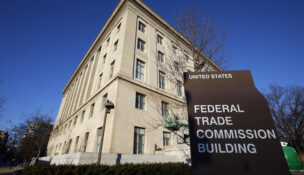Coronavirus sick leave law goes into effect Thursday
By: Michaela Paukner, [email protected]//March 31, 2020//
Coronavirus sick leave law goes into effect Thursday
By: Michaela Paukner, [email protected]//March 31, 2020//
Starting Thursday, many employers will have to provide paid leave to employees dealing with the coronavirus’ effects on themselves and their families.
The Families First Coronavirus Response Act, signed into law on March 18, provides up to two weeks of emergency paid sick leave and up to 10 additional weeks of expanded leave under the Family and Medical Leave Act to help employees who can’t work because of the coronavirus.
The law applies to private employers with fewer than 500 employees and certain public employers. It goes into effect on April 2 and continues through Dec. 31, 2020, unless Congress decides to extend it.
John Gardner, partner at DeWitt and chair of the firm’s Labor and Employment Practice Group, outlined what each type of leave means for Wisconsin employers.
Emergency paid sick leave
Under the FFCRA, covered employers are required to provide emergency paid sick leave to employees who can’t work or telework because:
- The employee is subject to a government quarantine or isolation order related to COVID-19. Gardner said Gov. Tony Evers’ “safer at home” order would qualify employees under this criteria.
- The employee has been advised by a health care provider to self-quarantine.
- The employee is experiencing symptoms of COVID-19 and seeking a medical diagnosis.
- The employee is caring for someone else who is subject to the government quarantine or has been advised to self-quarantine.
- The employee is caring for a child because the child’s school or childcare provider has been closed because of COVID-19.
- The employee is experiencing a similar condition to COVID-19. Gardner said this was an option the government has to broaden the leave under the law, but he thought it was unlikely to be used.
Full-time employees are entitled to up to 80 hours of leave. Part-time employees are entitled to an amount of leave equivalent to the average number of hours they work over two weeks. Employees can take leave regardless of how long they’ve been working for their current employer.
“If you have employer clients who are subject to this law, practically any employee of theirs can be eligible to take this leave, so long as they satisfy one of the six different reasons,” Gardner said.
The law says every employee who takes emergency paid sick leave must be compensated at his or her regular rate of pay for each hour of leave taken for any of the first three reasons.
“Frequently, that can be the employee’s hourly rate,” Gardner said. “Sometimes, it can be the employee’s salary broken down into an appropriate hourly rate, but you have to be aware of different bonuses that may be regularly provided to employees.”
The amounts are capped at $511 per day for a total of $5,110 for the entire two-week period.
If someone is taking the emergency paid sick leave for reasons 4-6, the employer must pay at least two-thirds of the employee’s regular rate of pay. This amount will be capped at $200 per day or $2,000 for the entire two-week period.
Expanded FMLA leave
Gardner said employees can only qualify for expanded FMLA leave if they are unable to work or telework because they need to care for a child whose school or childcare has been closed due to COVID-19.
Employees who have been working for an employer for 30 days or more are eligible for up to 12 weeks of paid leave. The first 10 days may be unpaid, but in reality, the employer would be substituting the first two weeks required for emergency paid sick leave, Gardner said.
The compensation for the remaining 10 weeks must be at least two-thirds of the employee’s regular rate of pay. This is capped at $200 per day and $10,000 total per employee.
Gardner said an employee is not qualified to continue this type of leave if schools and daycares reopen.
The law gives employees job restoration rights, but it relaxes the requirement in certain circumstances for employers with fewer than 25 employees.
Gardner said those small employers do not need to restore an employee if:
- The position held by the employee when the leave commenced does not exist due to economic conditions or other changes in the operation conditions of the employer caused by the public health emergency.
- The employer makes a reasonable effort to reinstate an employee upon the end of the leave.
- The employer makes additional reasonable efforts to contact the employee if the equivalent position becomes available in the next year.
Employers with fewer than 50 employees could be exempted by forthcoming regulations under certain limited circumstances.
“Unfortunately at this point, we don’t know what that exemption may be,” Gardner said. “I fully expect that the DOL will issue regulations along these lines. According to their website, they say such regulations should be expected in April of 2020.”
The DOL can choose to exempt health care providers, and Gardner said he expects the department to issue regulations broadly defining who qualifies as a health care provider.
Employer reimbursement
Gardner said an employer who provides paid leave pursuant to the FFCRA is eligible for tax credits against payroll tax obligations equal to the amount of paid leave provided in a calendar year. For example, an employer who pays $8,000 in payroll taxes spends $5,000 on emergency paid sick leave. The employer will then only owe $3,000 in taxes.
If an employer pays out more in leave benefits, the employer will receive a refund for the additional amount.
The payroll taxes that are available include federal income taxes, the employer’s share of social security and medicare taxes, and the employee’s share of social security and medicare taxes. Gardner said employers can use tax amounts for their total workforce, not only the employees taking leave.
Gardner said employers can request an accelerated payment from the IRS. The IRS said it expects to process requests in two weeks or less.
“The government is trying to go out of its way to help employers deal with this issue and provide payments where it can, but it’s going to be interesting to see how this reimbursement process works,” Gardner said.
Compliance issues
Gardner expected a number of compliance issues to arise from the FFCRA. He said employers should look to the DOL for guidance. The department issued its first set of regulations on Friday, including a Q&A addressing some of the most common FFCRA questions.
Gardner said the DOL is not enforcing the requirements for 30 days, starting on April 2, as long as the employer is acting in good faith to comply with the law.
“What this means is if the employer happens to screw up, but then later fixes that screw-up and also informs the DOL that the employer is going to do its best to comply going forward, the DOL is not going to take enforcement against that employer,” Gardner said.
However, employers shouldn’t wait to implement the new leave set to take effect on Thursday — at risk of later facing lawsuits from employees.
“Even though the DOL itself may be withholding on enforcement for the next month or so, we do not have the same time of period with respect to employee-related action,” Gardner said. Follow @WLJReporter
Legal News
- Chicago man sentenced to prison after being caught with ‘Trump Gun’
- FTC bans non-competes
- Gov. Evers seeks applicants for Dane County Circuit Court
- Milwaukee man charged in dismemberment death pleads not guilty
- Democratic-led states lead ban on the book ban
- UW Madison Professor: America’s child care crisis is holding back moms without college degrees
- History made in Trump New York trial opening statements
- Prosecutor won’t bring charges against Wisconsin lawmaker over fundraising scheme
- Republican Wisconsin Senate candidate says he doesn’t oppose elderly people voting
- Vice President Harris to reveal final rules mandating minimum standards for nursing home staffing
- Election workers fear threats to their safety as November nears
- Former law enforcement praise state’s response brief in Steven Avery case
WLJ People
- Power 30 Personal Injury Attorneys – Russell Nicolet
- Power 30 Personal Injury Attorneys – Benjamin Nicolet
- Power 30 Personal Injury Attorneys – Dustin T. Woehl
- Power 30 Personal Injury Attorneys – Katherine Metzger
- Power 30 Personal Injury Attorneys – Joseph Ryan
- Power 30 Personal Injury Attorneys – James M. Ryan
- Power 30 Personal Injury Attorneys – Dana Wachs
- Power 30 Personal Injury Attorneys – Mark L. Thomsen
- Power 30 Personal Injury Attorneys – Matthew Lein
- Power 30 Personal Injury Attorneys – Jeffrey A. Pitman
- Power 30 Personal Injury Attorneys – William Pemberton
- Power 30 Personal Injury Attorneys – Howard S. Sicula











